Mirrors in the interior of the living room: features, varieties, selection and installation
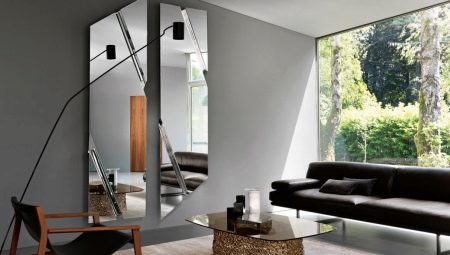
Mirrors are an integral element of design in any modern design style. They are able to visually increase the room, make it brighter and more comfortable. This article will discuss mirrors in the interior of the living room: common varieties, as well as the features of their selection and installation.
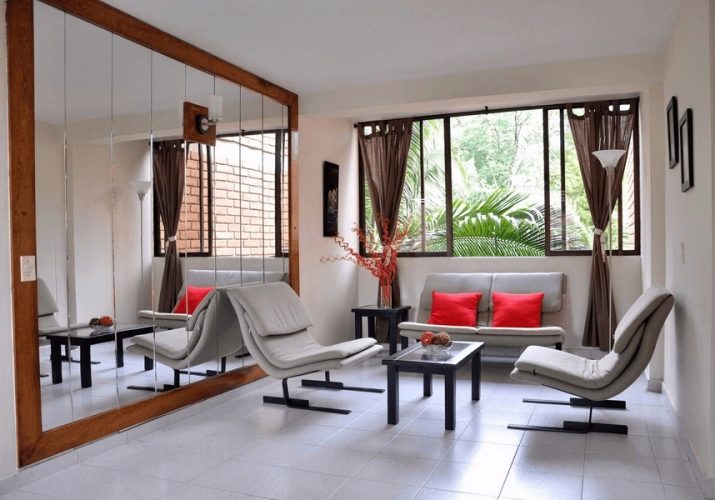
Appointment
If earlier the indoor mirror was used only for its intended purpose and performed its direct function, then Today it has become a full-fledged part of the interior and is able to perform a number of tasks in the design of the room.
- Mirror is a universal tool for expanding space in small apartments. It can naturally expand the room, make it more spacious, comfortable and voluminous. When designing a small room, specialists always add at least one mirror surface to the project.
- Quality lighting. In dark living rooms or rooms that lack light, you just can not do without such an important interior element as a mirror. In order to make maximum use of the capabilities of the mirrors, place them in front of illuminated or illuminated elements. Such elements may be a lamp, window or other reflective surface.
- Fullness and comfort. If your living room suffers from a lack of decoration and interior elements, a massive mirror can freely solve this problem. Mirroring visually increases the number of objects in the room, making it comfortable, but not overloaded.
- Change the dimensions of the room.Using mirrors with a specific shape, you can artificially change the parameters of your living room. So, a large vertical mirror will visually increase the height of your room, and a wide mirror on the entire wall will give it more natural volume.
- Style decision. Properly selected and expensive mirrors can give even the most mediocre living room an elegant and individual look.
- Find the accents. A properly located mirror can distinguish a certain object or group of objects from the background of the whole room. It can be either a regular tea set or a vase, shelves or shelving.
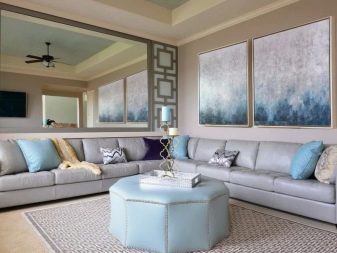
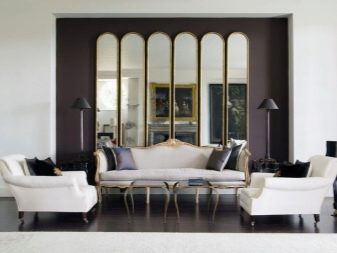
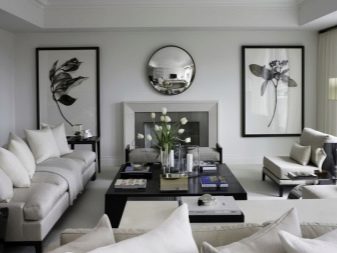
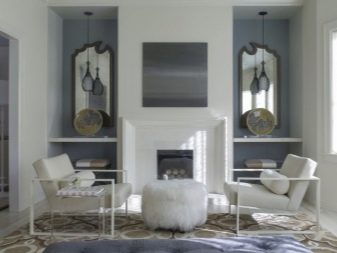
Kinds
Depending on the placement, all mirror elements can be divided into several varieties.
- Embedded. This variety, in turn, is divided into 2 independent species - built into furniture and built into niches and walls. For example, mirrors built into furniture today are considered not only a fashionable design move, but also a practical, rational interior solution. Built-in mirrors can be found in cabinets, chests of drawers and coffee tables.
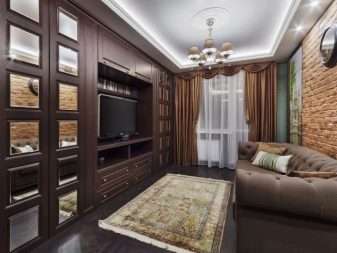

A variant of mirrors built into walls and niches is used in small rooms that need visual enlargement and lightening.
- Wall mounted. Usually these are not particularly large-size mirrors, which are used both to give the room more natural light, and for the harmony of the chosen style solution.
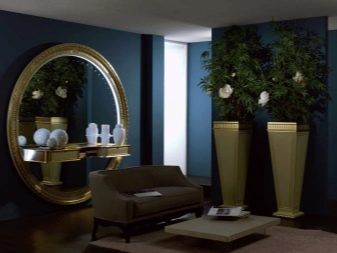
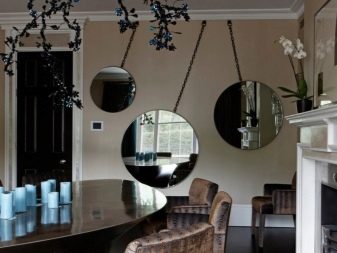
With proper placement, such models are also able to visually enlarge the room.
- Floor standing. These mirrors are fairly dimensional models with wide frames that are installed at an angle to the wall or placed on a special stand.
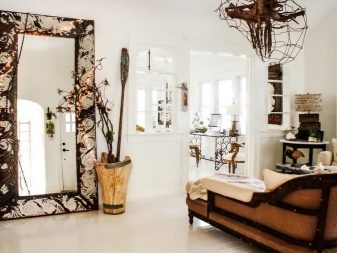
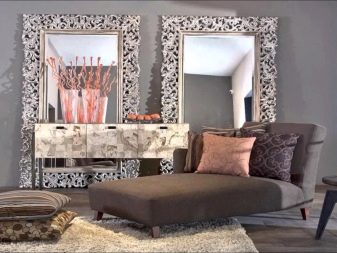
- Ceiling. This kind is preferred to be called mirrored ceilings. It is designed to increase the height of the room and give it greater depth.
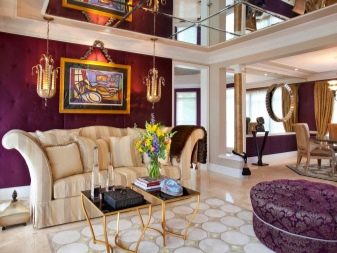

Shapes and sizes
Mirrors in the interior of the living room can be of various shapes and sizes, depending on the chosen design style and the available dimensions of the room. The most popular varieties will be listed below. Dimensions may be as follows:
- large - as a rule, the length or width of these models exceeds 100 cm; such models are used to visually enlarge the living room;
- small - this includes models of mirrors with a length or width of up to 50–70 cm; such mirrors perfectly complement the interior and focus on interior elements.
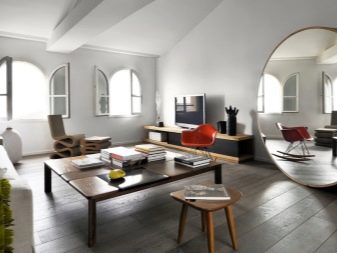
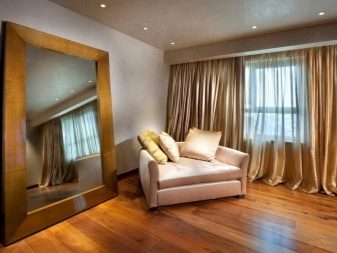
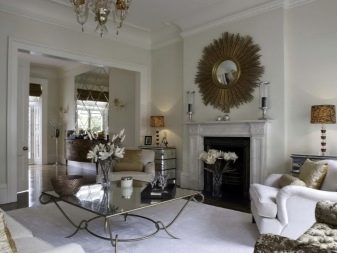
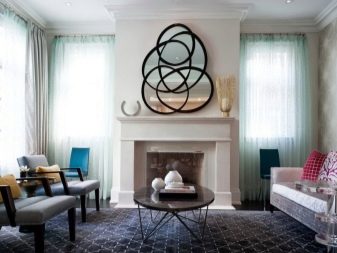
The shapes of the mirrors may be as follows:
- square - models of this form look great in strict and concise design styles, for example, minimalism;
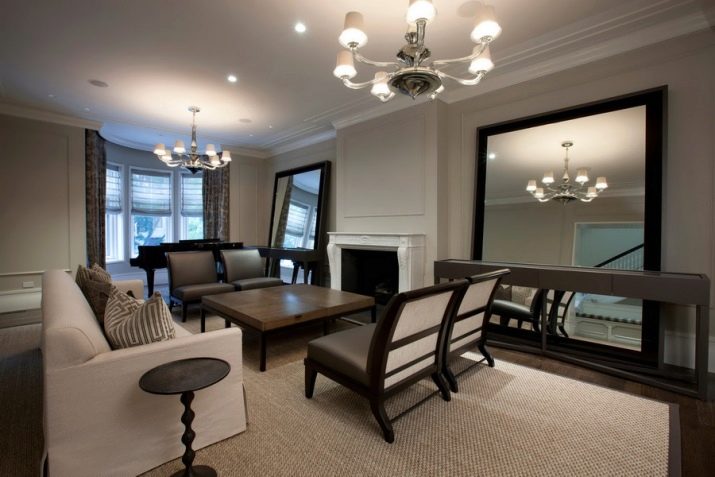
- rectangular - correctly selected rectangular mirrors are able to give the room proportionality and harmony, they look great in any style;

- round - a popular model for rooms in which there are not enough soft parts; round models bring comfort and order to the living room;
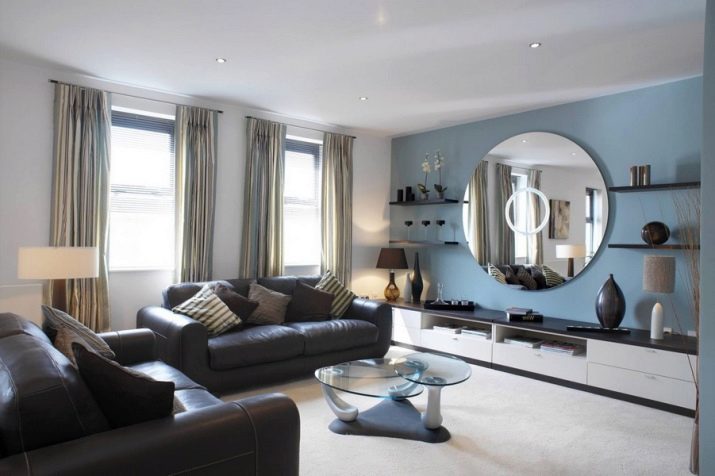
- oval - such mirrors do not focus on the elements of the interior, but balance the sharp and soft features in the interior of the room and smooth out the difference in different style decisions;
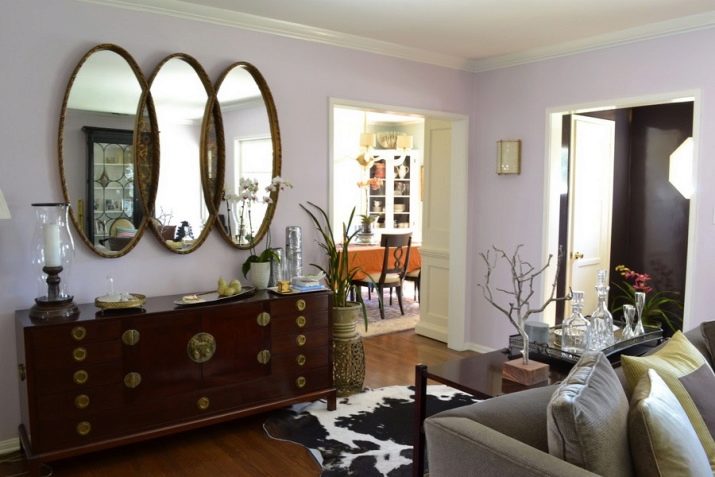
- curly - not a very popular version of mirrors, which is made to order and used in a strictly defined style; here curved and curved lines are not uncommon, which, for example, is characteristic of such a style as high-tech.
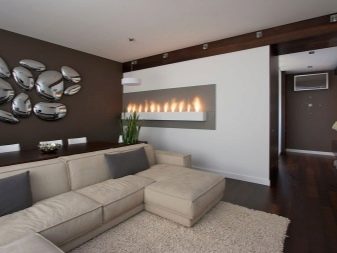
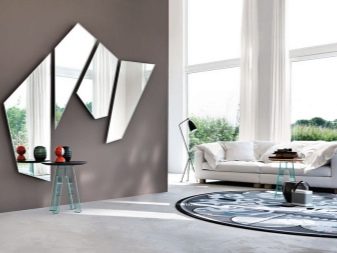
Style solutions
Mirrors can be used and designed in different ways depending on the chosen design style.
- Classic. For this style, models with wooden or wrought-iron frames are just perfect, and models of mirrors built into furniture — a cupboard, chest of drawers or a coffee table — will look good here.
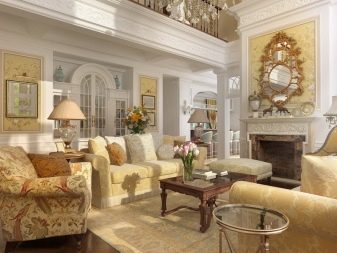

- Baroque. This design style looks great with mirrors, the frame components of which are made in the form of stucco, mosaics or gilding.
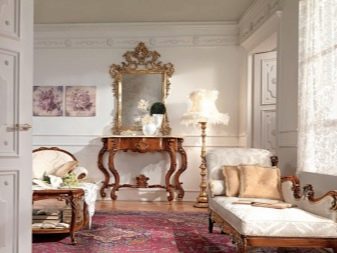
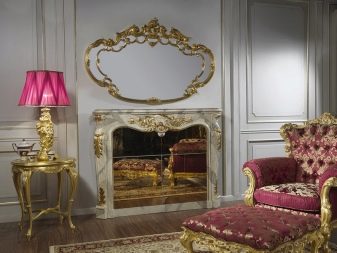
- Provence. For this style, models with numerous patterns are suitable.Models with wooden, metal or wooden stucco molding will look great here.
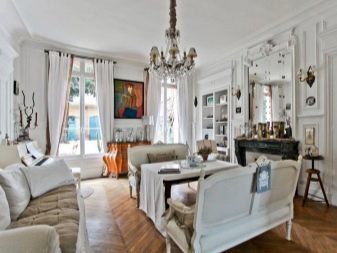

Unlike the Baroque style, Provence does not tolerate congestion, so even the stucco frames here are not particularly voluminous, but elegant.
- Country. Mirrors for the living room in this style should be framed with decorative twigs or rattan. This will give the whole room more natural comfort and warmth.


- Minimalism. This style prefers the most simple mirrors without frame components and facet.
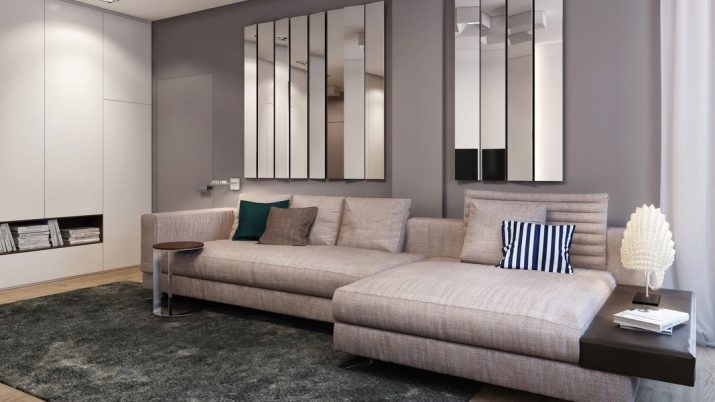
- Modern. In the design of mirrors of this style must be present natural motifs. If it is metal or wooden stucco, then made in the form of fancy leaves and branches.
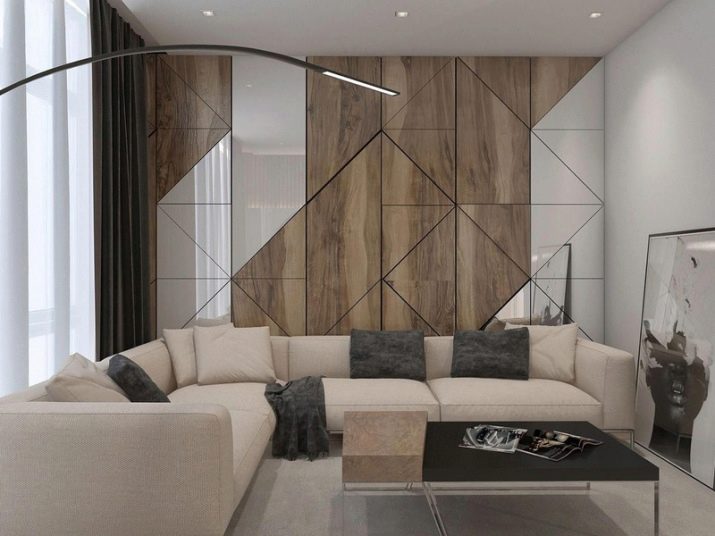
Design
Today in the mirror market you can find many models with the most diverse designs. Below will be located the most common design options for mirrors for the living room. Depending on the design of the frame elements, there are several types of mirrors.
- No frame elements. They look great in hi-tech style and minimalism, usually placed to give the living room more dynamism and spaciousness.
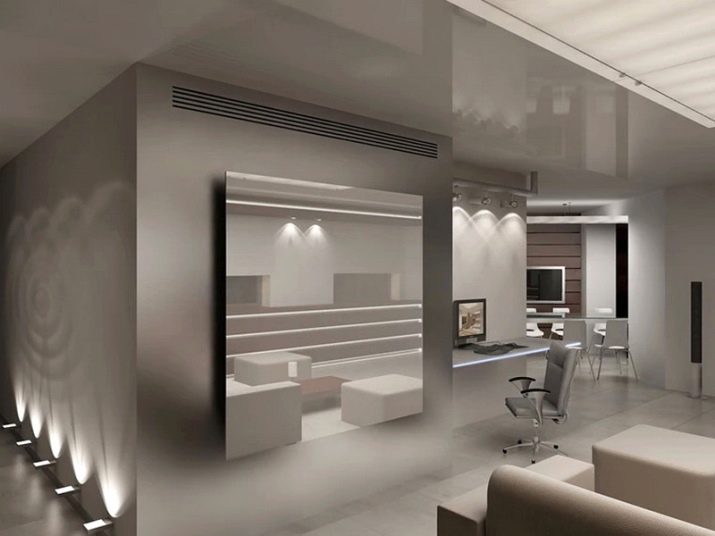
- Models with a frame. The frame can not only save the mirror from damage, but also perfectly fit the model into a certain interior or style (for harmony with furniture, paintings, flooring and other interior elements).
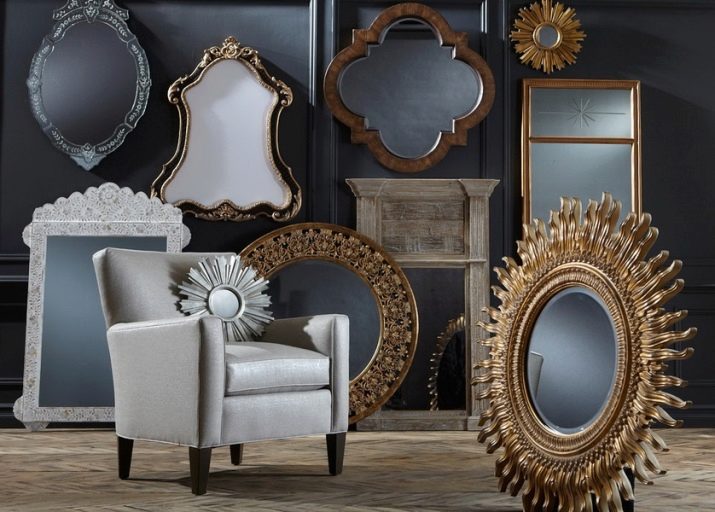
- Faceted models. The facet gives the mirrors a solid and rich look. Even the simplest in shape and size mirror facet can make stylish and beautiful.
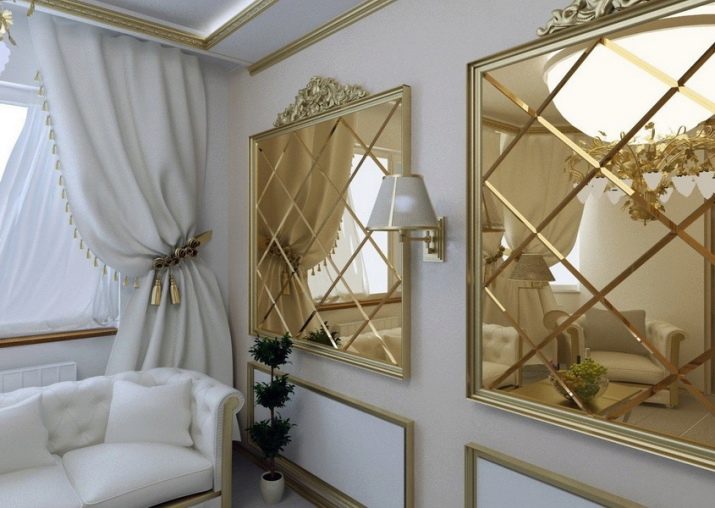
- Wooden frame elements. As a rule, they are in perfect harmony with the classic and Scandinavian styles in the interior, as well as perfectly complement the elements of wooden furniture.
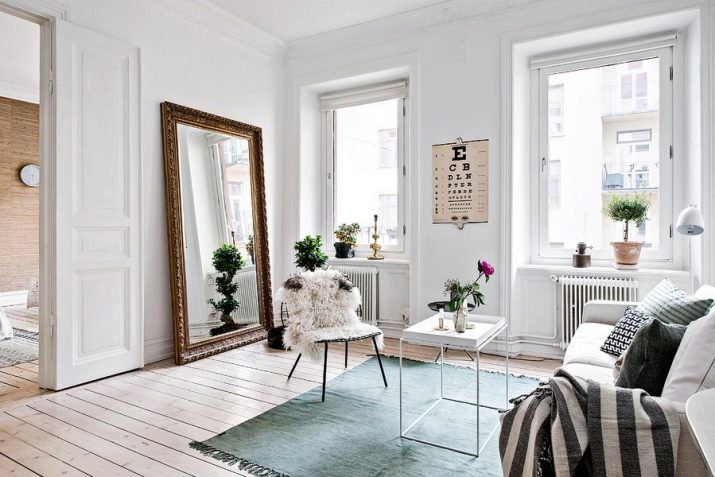
- With window bindings. This version of mirrors is designed to give the room coziness and harmony. Often such models are found in living rooms such as Provence or country.
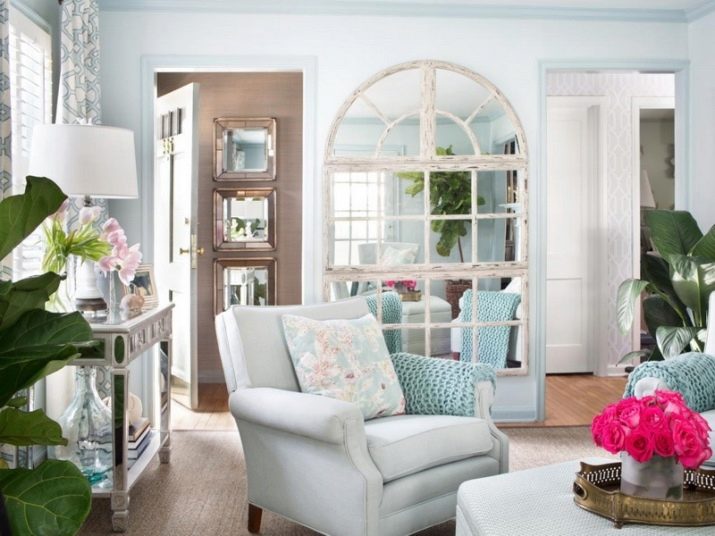
- Forged frames. This design of mirrors looks good in Victorian style, art deco, baroque and classic. Frames of this type are needed to bring rigor and completeness to the interior. Interesting and original design.
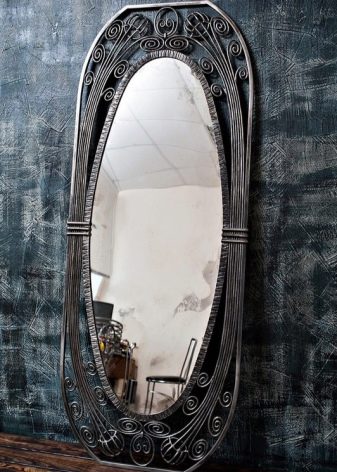
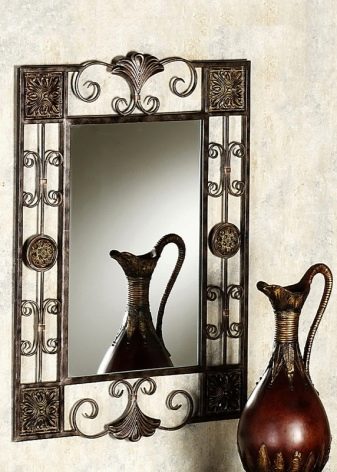
- Illumination under the frame or in place of the frame. Typically, these models have a special LED strip, which gives any mirror a mysterious look.
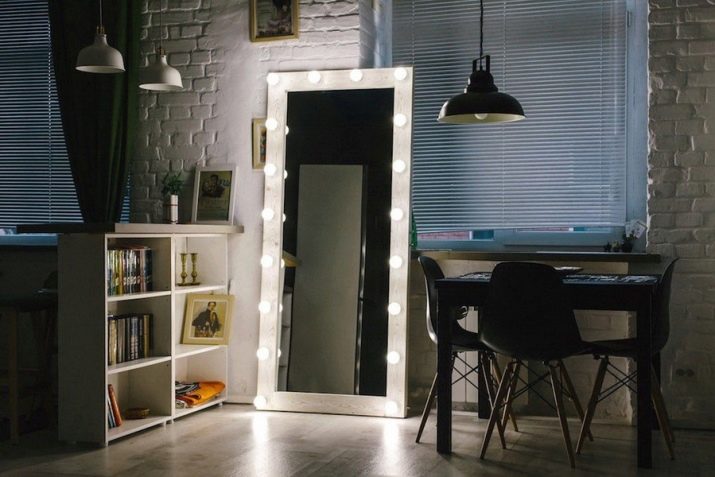
This option will look great in the style of art deco, hi-tech or minimalism - all depending on the way of lighting.
- Mirror panel. An extraordinary design option for the living room - in this case, the panel usually occupies a certain part of the wall and not only visually expands the room, but also reflects the sun's rays in a special way, thereby illuminating the entire room.
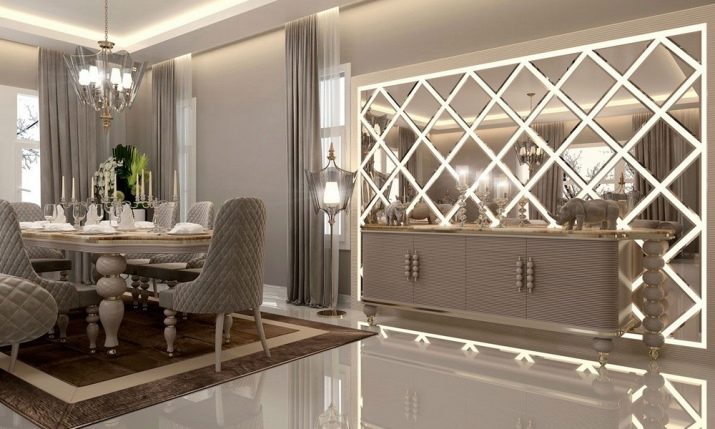
Models of this type give the room a special sense of style and solidity.
- The original decor. Models with frames in the form of mosaics, rhinestones, murals or stones. This version of mirrors refreshes the room, focuses on the winning elements of the interior.
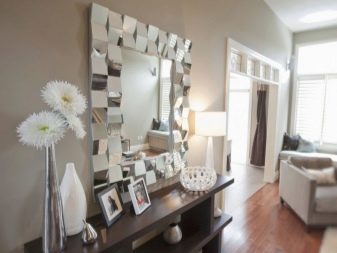
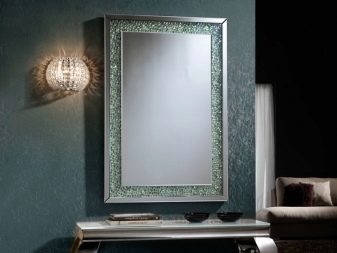
- Drawings. In some design styles, such patterns can look very advantageous - a particularly pleasant effect is created when light hits such patterns.
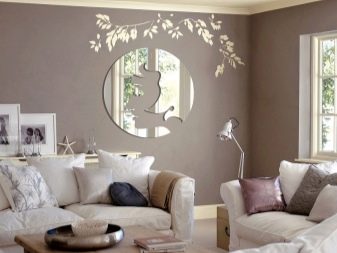
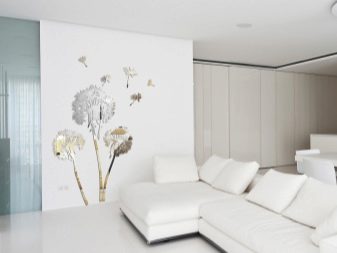
- Mirror compositions. In this case, using small mirrors of various shapes and sizes, original mirror surfaces are created. This option can look good in any interior, subject to the general style decision in the hall. Mirrored compositions are ideal for arranging an unusual living room in a non-standard style.
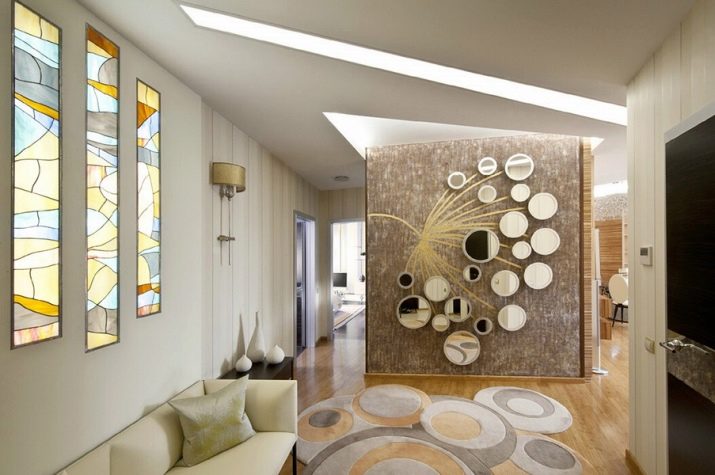
This installation method is able to recreate compositions of any size and shape.
- Curved models. Such mirror surfaces fulfill an exclusively entertaining and design function and can also be used to create unusual compositions.
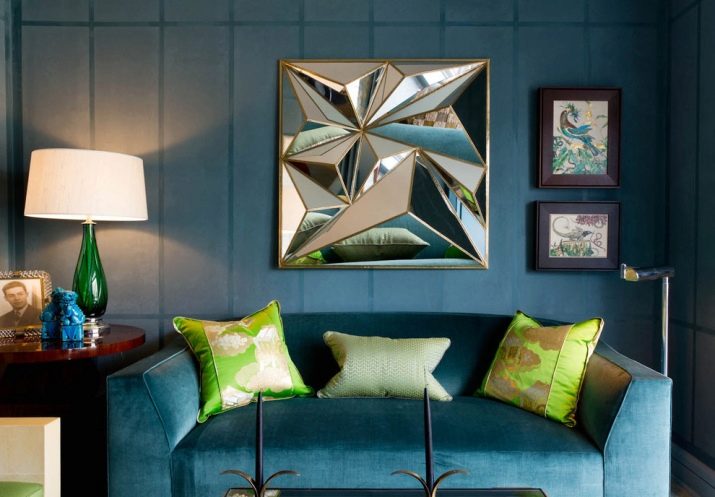
How to choose?
Since the mirror is a full-fledged element of the interior in modern apartments, you should be extremely careful about its choice. Below are points to which it is recommended to pay attention.
- Require manufacturer certificate. Despite the fact that mirrors do not apply to items that are subject to mandatory certification, you are entitled to require a certificate from the manufacturer itself. This document will indicate the materials to use in the manufacture of the model you purchased.
- Thickness. Remember, the thicker the mirror, the greater the chance that it will serve you for a long time - too thin models can not only have an uneven surface, but also deform over time from temperatures. Moreover, the thicker the model, the more durable and resistant it is to mechanical damage and transportation. The optimum thickness should be from 4 to 6 cm. Keep in mind that all high-quality models of mirrors are made of sheet silicate glass of brands M1, M2 and M3.
- Uniformity. The main sign of a good mirror is an absolutely smooth surface without rough areas, dots and scratches. Close attention should be paid to the presence of so-called air bubbles. If any of the described shortcomings is detected, such a model is not recommended.
- Coating. A quality mirror can be recognized by the number of coatings and the quality of the glass sheet. For example, in expensive models there are always three levels of coverage: reflective (usually silver), protective (previously copper films were used as anticorrosive materials, in modern models they were made of neutral metals), and another protective (presented in the form of several layers paint or polymer coating), it is designed to protect the mirror from damage and moisture.
- Design - Follow the design of the living room. Before choosing a mirror, do not forget to decide on the design style of the room and choose a mirror so that it does not stand out from the rest of the furniture and interior items.
- Sizes. When buying large models, make sure that you can deliver the model to your apartment - this can be hindered by the size of elevators, flights of stairs and intercom doors.
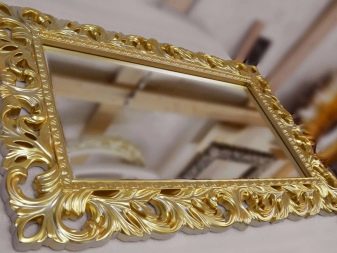
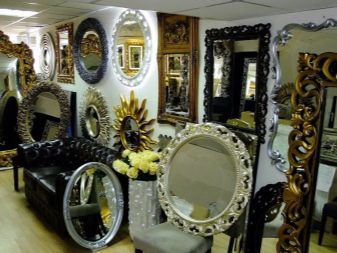
Where to install?
There are several ways to place mirrors in the living room.
- The entire wall or mirror wall. This is the most effective option for visually expanding the living room. This option will make even a poorly furnished room more saturated and comfortable, as well as lighten it qualitatively.
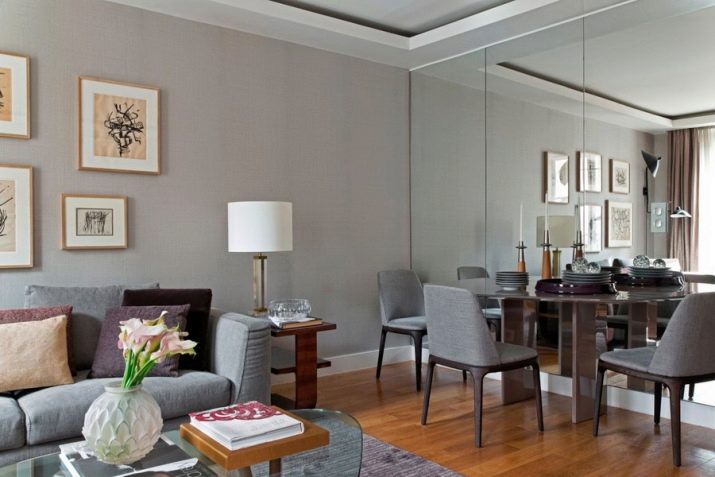
- Above the sofa. One of the most common options for placing mirrors. It is at the same time practical, since the mirror effectively performs its direct function and does not spoil the design solution of your living room.
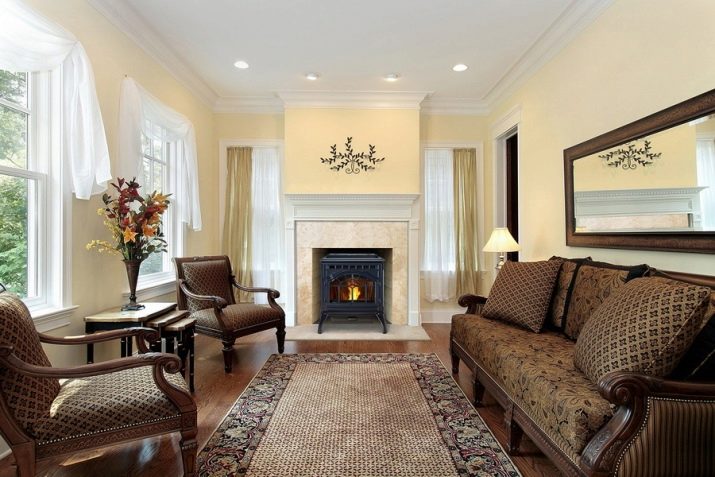
- In the corner. Models exhibited in such places are designed to visually continue the room, as well as to give it a special perspective thanks to a certain angle.
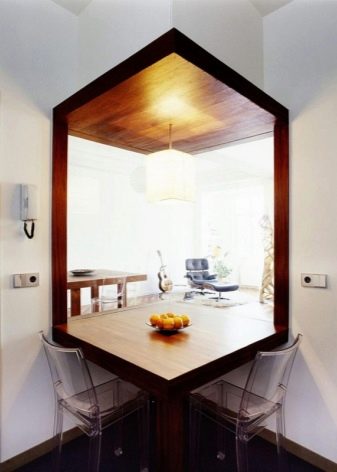
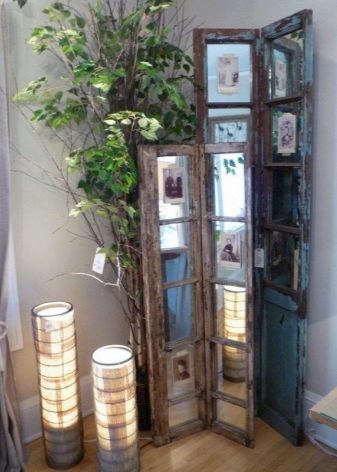
- In the area of the fireplace (usually above the fireplace). Thanks to some interior items exhibited on the fireplace (vases, lamps, clocks), the mirror creates a real compositional center of the entire living room.
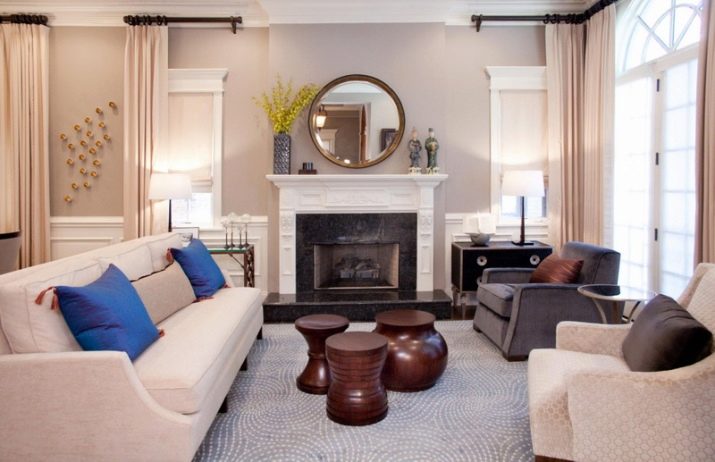
- In a wall or in a niche. A popular design option in fashion studios - here the model is designed not only to increase the size of the room, but also to fill your room with additional lighting.
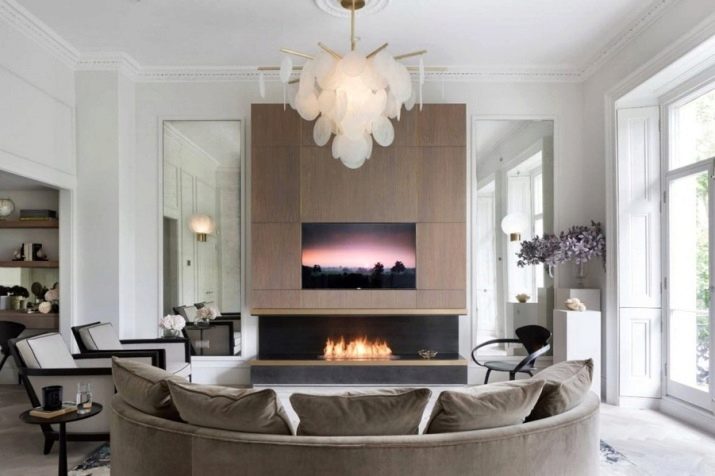
- Over the table. One of the best options - here the mirror surface fulfills its main task, and also gives the room depth and grace.
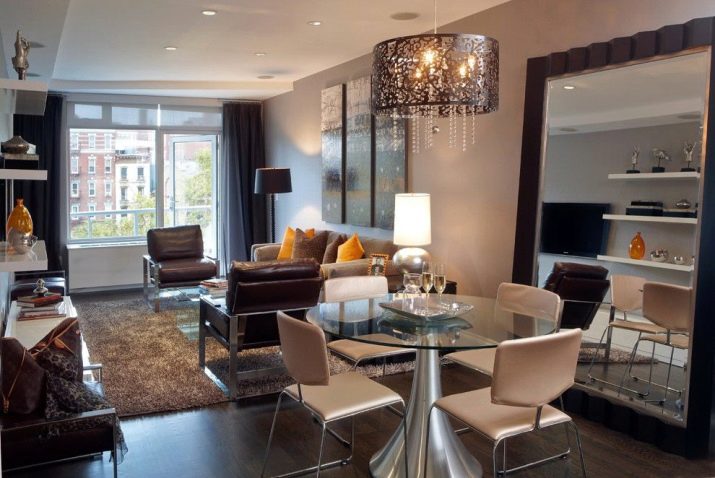
- Over the dresser. Incredibly fashionable option for placing mirrors in the styles of minimalism and baroque. It is believed that the mirror should be slightly narrower than the chest of drawers to create a more harmonious overall picture.

- Between the Windows. This technique is used in square rooms with a small amount of free space. Thanks to this arrangement, the impression of an additional window is created.
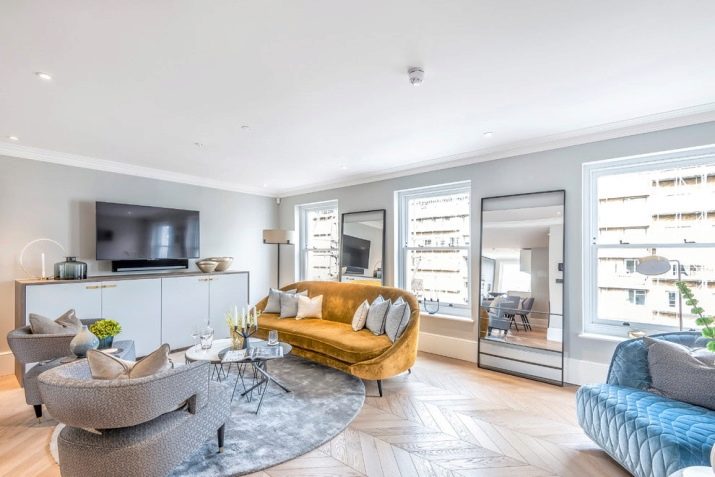
- In the area of the TV (usually from the sides or above the appliances). Against the background of the mirror surface, viewing any film looks especially exciting.
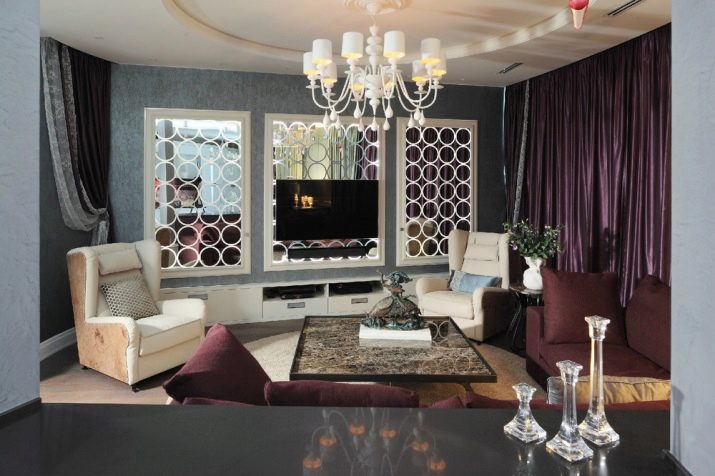
- On the ceiling. As already mentioned, these models are designed to visually raise the ceiling in your living room.Here, usually not solid mirror sheets are used to cover the ceiling, but many small reflective surfaces that together form one common composition.
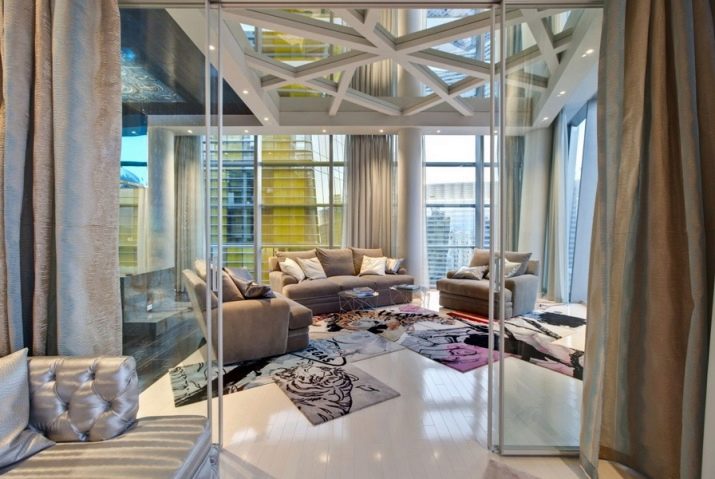
Beautiful examples
The following are successful and beautiful examples of placing mirrors in living rooms.
- An excellent solution for the living room in a classic style.
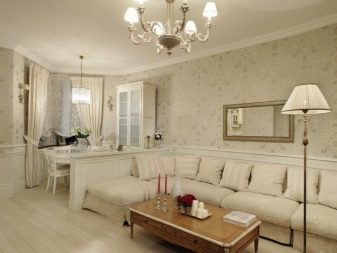
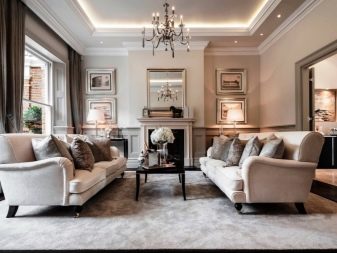
- Living room, made in the style of minimalism.


- Luxurious Baroque style.


- The best choice for high-tech style.
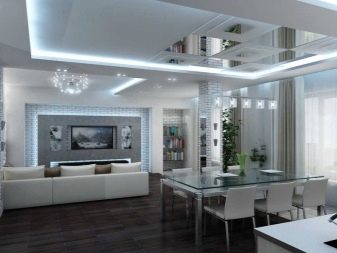
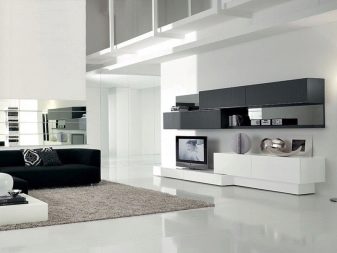
See how to transform a room using a mirror in the next video.









